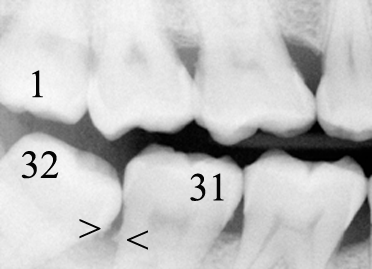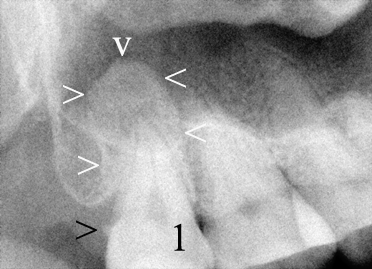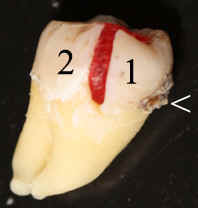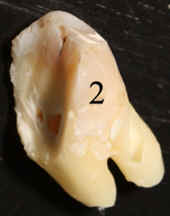 |
|
|
|
Fig.1 |
Fig.2 |
|
 |
|
|
|
Fig.3 |
Fig.4 |
Fig.5 |
 |
 |
|
|
Fig.6 |
Fig.7 |
|
 |
|
|
|
Fig.1 |
Fig.2 |
|
 |
|
|
|
Fig.3 |
Fig.4 |
Fig.5 |
 |
 |
|
|
Fig.6 |
Fig.7 |
|
Dental Education Lecture: Mini Wisdom Tooth
Wisdom tooth may be gigantic or tinny-tiny (Fig.2 *). The latter is hidden in the back of our mouth. It is difficult to clean well with formation of tartar (Fig.5 arrowhead) and gum disease. So we need to remove the mini wisdom tooth. The relatively normal-sized upper wisdom tooth is shown in Fig.1: #1. In addition, the two bottom wisdom teeth (#17,32) are pretty in a wrong position, causing formation of tartar in the wisdom tooth and its neighbor (Fig. 1 arrowheads) and possible cavity in the neighboring tooth (Fig.2 double #18 arrowheads). So the bottom wisdom teeth should be gone. The corresponding wisdom teeth on the top (1 and *) will become useless. They need to be out, too.
In the first appointment, we take out two top wisdom teeth (Fig.4,5) and do deep cleaning for the upper jaw. Fig.3 (X-ray taken before #1 tooth extraction) shows that the bone surrounding #1 is quite dense (white arrowheads) and that there is tartar in the back surface of #1. The latter is confirmed after tooth extraction (Fig.4 arrowhead). The thick root and the dense bone shown in Fig.3 imply that the extraction is not so easy. The extraction of the mini wisdom tooth is not easy, either, since the thin root is quite curvy (Fig.5*). However, the patient in his thirties is doing pretty well after the procedures.
Three weeks later he returns for deep cleaning for the lower jaw and taking out two wisdom teeth on the bottom. Since these two teeth are side way, we need to split the tooth into two (Fig.6 for #32) and several pieces (Fig.7 for #17) to reduce extraction resistance and complication. We use red wax to stick the two pieces of the wisdom tooth before taking photo (Fig.6). The white arrowhead in Fig.6 points to tartar with the bottom wisdom tooth, corresponding to that associated with the tooth #32 in Fig.1. In brief, it is very hard to keep the wisdom teeth clean , no matter whether they are big or small. We need to take them out as early as possible.
Xin Wei, DDS, PhD, MS 1st edition 11/26/2009, last revision 12/20/2009